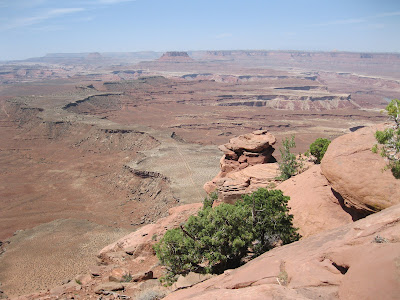The Hunter Canyon Trail and campground is located about 7.5 miles west along Kane Creek Road, west of Highway 191 in Moab in southeast Utah. The gravel road continues on for about 3.5 miles to a junction with the Kane Creek Trail and then another 3.0 miles to Hurrah Pass.
This route is a popular area for mountain biking and motorized but hikers can use the road also. The first segment meanders in a shady deep walled canyon along the bank of Kane Creek.
After about 1 mile the views open up. The canyon wall to the north is part of the view that is visible from the Anticline Overlook at the north end of the Canyon Rims Recreation Area. The rock layers have a slight curve to them. There isn't much vegetation here except for the riparian habitat in Kane Creek.
Toward the south the Anticline Overlook Point is visible to the west. With binoculars, the safety railings around the point are visible. The Hurrah Pass is directly north of and below the point.
In the fall of 2012, there are the new Ledge Campgrounds in this area. There are the Ledge A, B, and C and a Group site. These campgrounds replace the dispersed sites that were along Kane Creek. The new campgrounds improve the sanitary conditions for camping in this area. For hikers, this can be a place to sit and enjoy the views.
Many of the replaced camping areas are now fenced off to allow the vegetation to recover. The Ledge B and C campgrounds are close to the junction with the Kane Creek Trail.
I turned around at the junction of the main road with the junction with the rougher Kane Creek Canyon Trail that goes to the left. Staying to the right on the main trail leads to the Hurrah Pass and Chicken Corners. Almost all vehicles can drive to this junction and start hikes here.
It took me 1:40 hours to arrive at the junction with the Kane Creek Canyon Trail. My return hike took 1:30 hours for a total hike of 3:40 hours for about 7 miles. I carried 3 liters of water on a 64 F degree early November day.







































